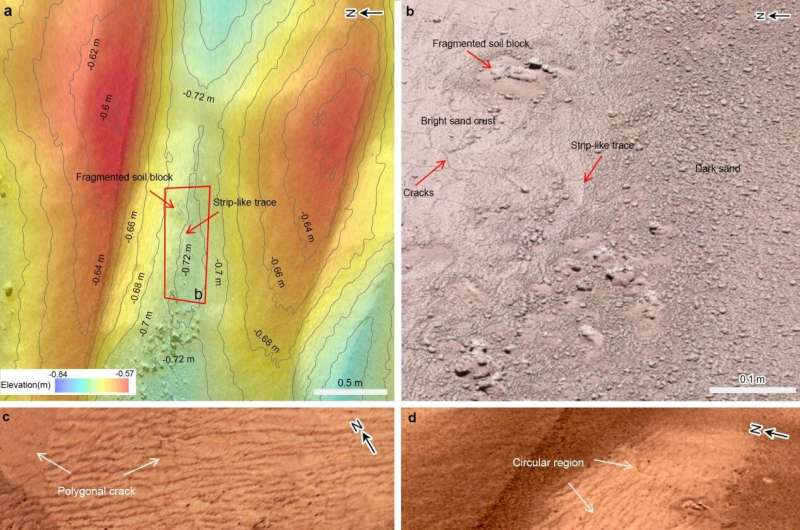This article has been reviewed according to Science X's editorial process and policies. Editors have highlighted the following attributes while ensuring the content's credibility:
fact-checked
peer-reviewed publication
trusted source
proofread
Tianwen-1: Zhurong rover finds evidence of water at low latitudes on modern Mars

The Zhurong rover has found evidence of water on dune surfaces on modern Mars by providing key observational proof of liquid water at low Martian latitudes, according to a study led by Prof. Qin Xiaoguang from the Institute of Geology and Geophysics (IGG) of the Chinese Academy of Sciences (CAS).
Researchers from the National Astronomical Observatories of CAS and the Institute of Atmospheric Physics of CAS were also involved in the study. The study was published in Science Advances on April 28.
Previous studies have provided proof of a large amount of liquid water on early Mars, but with the escape of the early Martian atmosphere during the later period, the climate changed dramatically. Very low pressure and water vapor content make it difficult for liquid water to sustainably exist on Mars today. Thus, it has been widely believed that water can only exist there in solid or gaseous forms.
Nonetheless, droplets observed on the Phoenix's robotic arm prove that salty liquid water can appear in the summer at current high latitudes on Mars. Numerical simulations have also shown that climatic conditions suitable for liquid water can briefly occur in certain areas of Mars today. Until now, though, no evidence has shown the presence of liquid water at low latitudes on Mars.
Now, however, findings from the Zhurong rover fill the gap. The Zhurong rover, which is part of China's Tianwen-1 Mars exploration mission, successfully landed on Mars on May 15, 2021. The landing site is located at the southern edge of the Utopia Planitia (UP) Plain (109.925 E, 25.066 N), where the northern lowlands unit is located.
The researchers used data obtained by the Navigation and Terrain Camera (NaTeCam), the Multispectral Camera (MSCam), and the Mars Surface Composition Detector (MarSCoDe) aboard the Zhurong rover to study the different-scale surface features and material compositions of dunes in the landing area.
They found some important morphological features on the dune surfaces, such as crusts, cracks, granulation, polygonal ridges, and a strip-like trace. The analysis of spectral data revealed that the dune surficial layer is rich in hydrated sulfates, hydrated silica (especially opal-CT), trivalent iron oxide minerals (especially ferrihydrite), and possibly chlorides.
"According to the measured meteorological data by Zhurong and other Mars rovers, we inferred that these dune surface characteristics were related to the involvement of liquid saline water formed by the subsequent melting of frost/snow falling on the salt-containing dune surfaces when cooling occurs," said Prof. Qin.
Specifically, salts in dunes cause frost/snow to melt at low temperatures to form salty liquid water. When the saline water dries, the precipitated hydrated sulfate, opal, iron oxide, and other hydrated minerals cement sand particles to form sand aggregates and even crust. Then the crust is further cracked by shrinkage. The later frost/snow melting process further forms polygonal ridges and a strip-like trace on the crust surface.
The estimated age of the dunes (about 0.4–1.4 million years) and the relationship among the three phases of water suggest that the transfer of water vapor from the polar ice sheet toward the equator during the large obliquity stages of Mars's late Amazonian period led to repeated humid environments at low latitudes. Therefore, a scenario of water activity has been proposed, i.e., cooling at low latitudes during Mars's large obliquity stages prompts frost/snow to fall and subsequently results in the formation of crusts and aggregates on the salty dune surface, thus solidifying dunes and leaving traces of liquid saline water activity.
The discovery provides key observational evidence of liquid water at Martian low latitudes, where surface temperatures are relatively warmer and more suitable for life than at high latitudes.
"This is important for understanding the evolutionary history of the Martian climate, looking for a habitable environment, and providing key clues for the future search for life," said Prof. Qin.
More information: Xiaoguang Qin et al, Modern water at low latitudes on Mars: Potential evidence from dune surfaces, Science Advances (2023). DOI: 10.1126/sciadv.add8868. www.science.org/doi/10.1126/sciadv.add8868
Journal information: Science Advances
Provided by Chinese Academy of Sciences





















